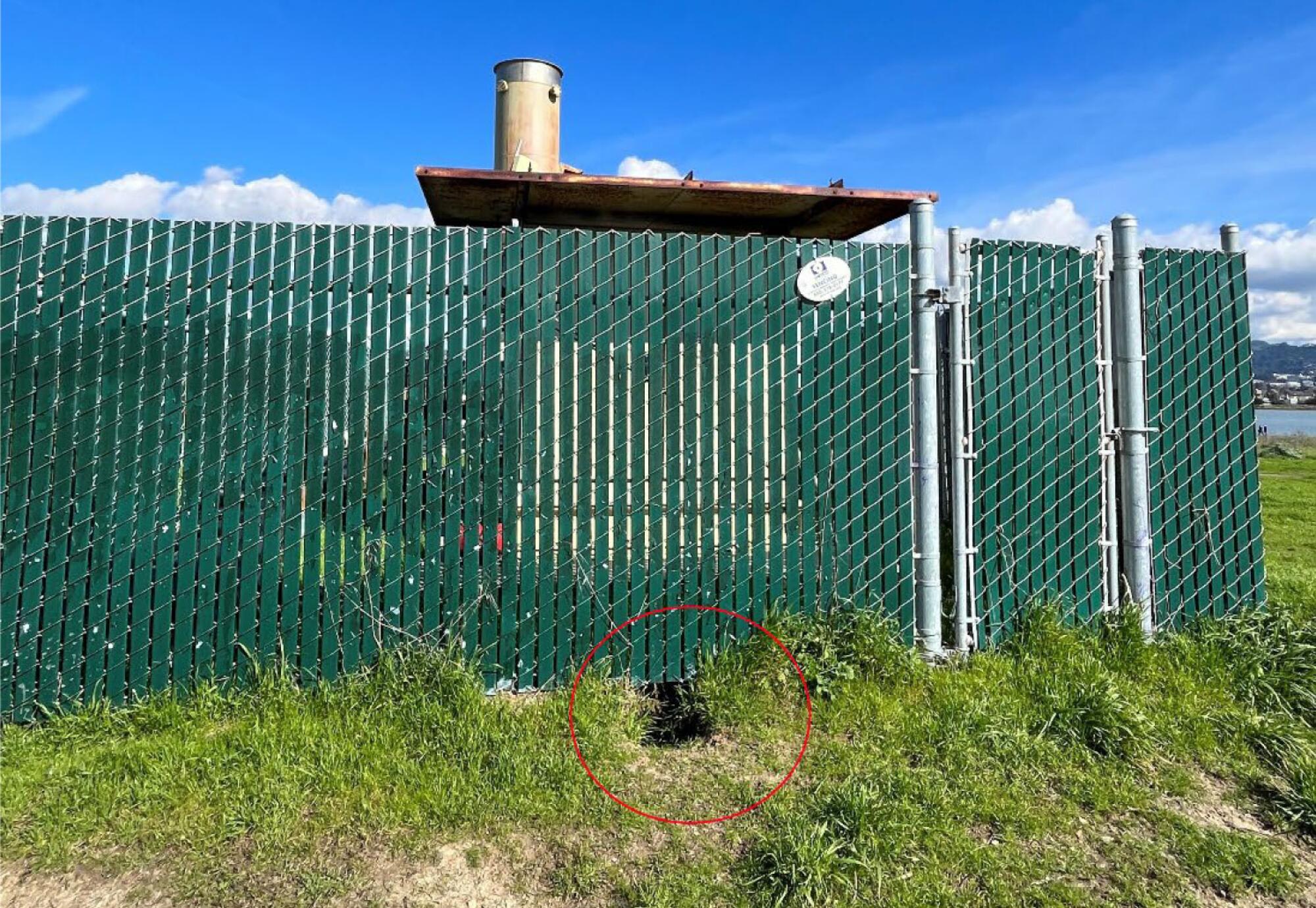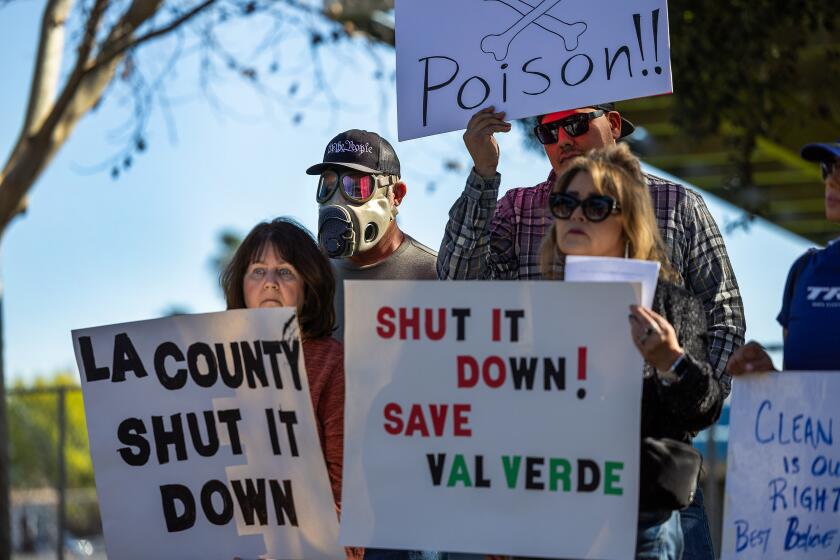
- Share via
Brimming with wildlife and offering panoramic views of San Francisco Bay, César Chávez Park welcomes visitors who might never suspect this stretch of shoreline was built atop a municipal landfill.
But beneath the sprawling grasslands and charming hiking trails, decomposing waste continues to generate methane gas. That’s why the city of Berkeley operates an underground system that collects this flammable gas and torches it at a large mechanical flare near the center of the park.
Aggressive and impactful reporting on climate change, the environment, health and science.
In recent years, environmental regulators have grown increasingly concerned that this equipment has fallen into disrepair and released landfill gases. The Bay Area Air Quality Management District has fined Berkeley after finding explosive levels of methane leaking from at least two cracked gas collection wells in the park. Both have since been repaired.
As the landfill has experienced power outages and equipment breakdowns, the air district also suspects methane is migrating underground toward another bustling area. The agency warns that ignitable levels of methane have been observed in shallow soil surrounding a nearby hotel and the Berkeley Marina.
“Methane there could explode under the right conditions such as a passerby dropping a lit cigarette on a still day,” air district attorney Joel Freid said at a public meeting in February.
Yet there have been no evacuations or closures in that time, as local officials have insisted there is no public safety risk. Berkeley officials and city contractor SCS Engineers also contend that the landfill is not the source of the high methane concentrations near the hotel, saying it could be produced naturally.
In the last year, Berkeley officials and the air district have sparred over whether the landfill-turned-park should upgrade its pollution controls. The outcome will hinge on new testing, as state and local regulators have recently called on Berkeley to investigate the source of the methane and take steps to thoroughly inspect its pollution control system for leaks.
“We are working closely with regulators to ensure that any errors in operations do not occur again,” said Matthai Chakko, a spokesperson for the city. “This includes regular testing, sampling and stringent safety protocols to ensure the system’s integrity.
“The park continues to be a thriving, safe area for dog walkers, kite fliers and those bringing family for walks.”
Across California, aging landfills have presented communities with myriad problems, as these sites have struggled to control flammable methane emissions and toxic air pollution. Berkeley Landfill, closed more than 30 years, highlights the long-lasting health and safety risks associated with landfills, especially as communities have sought to reuse this land to build schools and parkland.
Given the risks, Dr. David Carpenter, founder of the Institute for Health and the Environment at the University of Albany, questions why public officials would convert former landfills into public spaces at all.
“It’s outrageous. It’s like Love Canal all over again,” said Carpenter, referring to the industrial dump in Niagra Falls, N.Y., that was disastrously turned into a neighborhood in the late 1970s. “It’s land that nobody else wants. And it gets used for public purposes, like parks and schools.”
About 1.5 million tons of waste, including industrial debris from a steel mill, were dumped over the years into the now-decommissioned Berkeley Landfill. Like other municipal dumps, it generally consists of layers of compacted waste and soil that eventually was sealed with a layer of clay.
Similar to oil and gas companies, landfill operators drill and construct a network of deep wells that extract gases produced by decomposing organic waste, such as food scraps. These wells must operate long after a site is closed to prevent gases from migrating to unwanted areas.
Calls are growing for the closure of Chiquita Canyon Landfill, yet experts say that shutting the facility down won’t solve the problem.
But in recent years, the air district has become concerned with the condition of the Berkeley landfill’s equipment and maintenance. It issued at least 14 air quality violations in 2023.
Most notably, in July, air district inspectors smelled a “rotten egg” odor emanating from a gas well. As they opened the well and attempted to gauge methane concentrations, their monitoring device “flamed out,” indicating explosive levels of methane, according to Bay Area AQMD air quality specialist Grace Leung.
Stephen Harquail, a Portland, Ore.-based landfill manager for SCS Engineers, placed a cone on the well to mark it, Leung said. But the leaky well was not repaired for a week. Meanwhile, the air district said, the public had full access to the park.
Air district inspectors also found that duct tape and foil had been used to regulate airflow on the landfill flare. And Harquail couldn’t find five of the landfill’s 42 wells, which may have been buried by construction or groundskeeping. He told the inspectors he has occasionally used a pickax to try to unearth them.
“He told me it’s like looking for a needle in a haystack,” Leung said at an air district meeting in February. “He doesn’t know where they are.”
Harquail did not respond to requests for comment.
Since 2019, the gas control system, flare system and gas wells have gone off-line for periods of hours to several days, often because of power outages. In that time, soil probes around the nearby DoubleTree hotel have regularly detected methane above 5%, the minimum threshold to ignite. At least two readings have been higher than 80%. A spokesperson for the hotel could not be reached.
Commercial natural gas for heating and cooking is typically 85% to 95% methane gas.
“That is a significant concern from a safety perspective,” said Seth Shonkoff, director of the Oakland-based nonprofit research group PSE Healthy Energy. “Unless there’s some sort of subsurface migration of methane to the surface, you should not see that level of that magnitude, ever.”
Shonkoff also noted that methane, including in landfill gas, is often commingled with other toxic air contaminants, including benzene, for which there is no safe level of exposure.
“The science on landfill gas composition is relatively young, so there’s a lot to learn,” he said. “But we do know that methane is a solvent, meaning that a variety of chemicals can be intermixed and be dissolved into it.”

After more than 40 years, Martin Nicolaus can still remember how bleak Berkeley’s shoreline looked when a human-made peninsula jutting into San Francisco Bay served as the city’s municipal dump.
Nicolaus, a longtime Bay Area resident, was stunned by the bottleneck of truck traffic, the expansive field of rancid garbage and the multitude of pests it attracted.
“There were just mobs of rats and gulls shrieking overhead, grabbing whatever it might be edible there,” said Nicolaus, who is now president of the Chavez Park Conservancy. “It was a lively scene.”
But shortly after the city-owned landfill was ultimately closed in 1990, the grounds underwent a dramatic transformation. Berkeley officials embarked on an ambitious plan to convert the former waste site into the present-day park.
The 90 acres of open space evolved into a popular destination, known for hiking trails and scenic views. It is home to an assortment of community events, including guided walks and an Easter egg hunt. It’s also brimming with native grasses, wildflowers and myriad bird species.

One creature that may be making matters worse, though, is ground squirrels. They have been burrowing warrens underground across the park’s peninsula, including near the flare station, heightening concerns about potential gas leaks and spills of contaminated liquids.
But the city met stiff opposition to trapping or exterminating the rodents.
Nicolaus said the air district statements are alarmist. He has expressed concerns over how extensive repairs might disrupt the decades of habitat restoration work.
“Ground squirrel burrows are all over the park,” Nicolaus said. “You couldn’t probably find a square 10-yard area in the parkway that doesn’t have a ground squirrel burrow in it. But are they going to chew through a plastic pipe? And, no, I don’t think so.”
The city has contended that the landfill is producing significantly less methane since its closure. They say it’s not enough gas to continuously operate the gas collection system and flare.
The air district, however, argues that leaky equipment is releasing landfill gases into the environment, which is why there’s much less methane being collected.
Another worry is oxygen. Oxygen levels around 20% — about the same concentration as in Earth’s atmosphere — have been measured deep inside some of Berkeley’s gas wells, indicating a leak or malfunction, according to the air district. Typically landfills try to keep oxygen levels to less than 5%, because higher levels can speed up decomposition, produce heat and raise the risk of an underground landfill fire.
Berkeley has been ordered to fly a drone over Chávez Park and neighboring areas to search for leaks. It has also been called on to conduct an analysis comparing the landfill gas and the underground methane near the hotel and marina to determine whether they’re from the same source.
If the gas is traced back to the landfill, the city will be required upgrade its gas collection system. Replacing the entire system is expected to cost $2 million. But even if another source is responsible for the methane, the city must still find a way to abate hazardous conditions and protect people visiting the hotel and marina.
“If I had the option to stay or walk somewhere else,” Shonkoff said, “I would probably exercise that option.”
The end of Berkeley’s first-in-the-nation ban on gas hookups is a setback for the climate, but a small one. Electric appliances remain better and more efficient.










